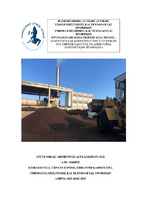| dc.contributor.advisor | Στρατή, Ειρήνη | |
| dc.contributor.author | Αγγελακόπουλος, Δημήτριος | |
| dc.date.accessioned | 2023-09-05T09:09:48Z | |
| dc.date.available | 2023-09-05T09:09:48Z | |
| dc.date.issued | 2023-07-11 | |
| dc.identifier.uri | https://polynoe.lib.uniwa.gr/xmlui/handle/11400/5010 | |
| dc.identifier.uri | http://dx.doi.org/10.26265/polynoe-4848 | |
| dc.description.abstract | Η ανοδική τάση που παρουσιάζει η παγκόσμια παραγωγή ελαιόλαδου επιφέρει αύξηση
των υποπροϊόντων της. Η ελαιοπυρήνα αποτελεί το κύριο στερεό απόβλητο της
ελαιοπαραγωγικής διαδικασίας καθώς από 100 g ελιάς παράγονται περίπου 35 g
ελαιοπυρήνας. Έτσι η αξιοποίηση της ελαιοπυρήνας παρουσιάζει μεγάλο ερευνητικό,
εμπορικό και περιβαλλοντικό ενδιαφέρον και αποτελεί το θέμα της παρούσας
εργασίας. Με αυτόν το σκοπό γίνεται αναφορά των διαφορετικών διαδικασιών που
μπορούν να πραγματοποιηθούν για την παραγωγή ελαιόλαδου, καθώς οδηγούν σε
ελαιοπυρήνα διαφορετικής σύστασης. Οι πιθανές μέθοδοι αξιοποίησης της
ελαιοπυρήνας που αναλύονται είναι η παραγωγή πυρηνέλαιου και η παραγωγή
λειτουργικών τροφίμων. Η διαδικασία παραγωγής πυρηνελαίου βρίσκει μεγάλη
απήχηση καθώς αποτελεί κλειστό κύκλωμα επεξεργασίας με λίγα έως καθόλου
απόβλητα. Τα προϊόντα της είναι πάντα το πυρηνέλαιο και το πυρηνόξυλο ωστόσο τα
στάδια που περιέχει παρουσιάζουν διαφορές ανάλογα με την φύση της ελαιοπυρήνας.
Συγκεκριμένα, συγκριτικά με την ελαιοπυρήνα που προκύπτει από φυγοκέντρηση 3-
φάσεων, διαφορές προκύπτουν κυρίως αναφορικά με τις εναλλακτικές μεθόδους που
πραγματοποιούνται για την μείωση της περιεχόμενης υγρασίας στην ελαιοπυρήνα που
προκύπτει από φυγοκέντρηση 2-φάσεων. Γίνεται ακόμα αναφορά στο πλούσιο
βιοδραστικό προφίλ της ελαιοπυρήνας, το οποίο εμπεριέχει μονοακόρεστα λιπαρά οξέα
και διάφορα δευτερεύοντα συστατικά, που της προσφέρουν μεταξύ άλλων
αντιοξειδωτικές, υποχοληστερολαιμικές και αντικαρκινικές δράσεις. Έτσι η
αξιοποίηση των θρεπτικών συστατικών της για την παραγωγή λειτουργικών τροφίμων
παρουσιάζει ιδιαίτερο ενδιαφέρον καθώς ταυτόχρονα μειώνει την εξάρτηση της
εμπορικής αξίας της από την ελαιοπεριεκτικότητα της. Σε αυτό το πλαίσιο γίνεται
αναφορά της εισαγωγής διάφορων μορφών της ελαιοπυρήνας σε βρώσιμα έλαια,
ζυμαρικά, αρτοσκευάσματα και ζωοτροφές. | el |
| dc.format.extent | 49 | el |
| dc.language.iso | el | el |
| dc.publisher | Πανεπιστήμιο Δυτικής Αττικής | el |
| dc.rights | Αναφορά Δημιουργού - Μη Εμπορική Χρήση - Παρόμοια Διανομή 4.0 Διεθνές | * |
| dc.rights | Attribution-NonCommercial-NoDerivatives 4.0 Διεθνές | * |
| dc.rights.uri | http://creativecommons.org/licenses/by-nc-nd/4.0/ | * |
| dc.subject | Πυρηνέλαιο | el |
| dc.subject | Λειτουργικά τρόφιμα | el |
| dc.title | Παραγωγή και αξιοποίηση των συστατικών του πυρηνελαίου για την δημιουργία λειτουργικών τροφίμων | el |
| dc.title.alternative | Production and utilization of pomace olive oil ingredients for the production of functional foods | el |
| dc.type | Πτυχιακή εργασία | el |
| dc.contributor.committee | Τσάκαλη, Ευσταθία | |
| dc.contributor.committee | Κοντελές, Σπυρίδων | |
| dc.contributor.faculty | Σχολή Επιστημών Τροφίμων | el |
| dc.contributor.department | Τμήμα Επιστήμης και Τεχνολογίας Τροφίμων | el |
| dc.description.abstracttranslated | The upward trend shown in the global olive oil production results in an increase in its
by-products. The olive pomace is the main solid waste of the olive oil production
process as approximately 35 g of olive pomace is produced from 100 g of olives. Thus,
the utilization of the olive pomace is of great research, industrial and environmental
interest and is the subject of this paper. With this purpose, reference is made to the
different processes that can be carried out for the production of olive oil, as they lead
to olive pomace of different composition. The possible utilization methods of olive
pomace analyzed are the production of olive pomace oil and the production of
functional foods. The olive pomace oil production process finds great appeal as it is a
closed processing system with little to no waste. Its products are always the olive
pomace oil and exhausted pomace cake, however the stages it contains show differences
depending on the nature of the olive pomace. Specifically, compared to the olive
pomace resulting from 3-phase centrifugation, differences arise mainly regarding the
alternative methods carried out to reduce the moisture content in the olive pomace
resulting from 2-phase centrifugation. Reference is also made to the rich bioactive
profile of the olive pomace, which contains monounsaturated fatty acids and various
secondary components, which offer, among other, antioxidant, hypocholesterolemic
and anticancer effects. Thus, the utilization of its nutrients for the production of
functional foods is of particular interest as it also reduces the dependence of its
commercial value on its oil content. In this context, mention is made of the introduction
of various forms of the olive pomace into edible oils, pasta, pastries and animal feed. | el |


